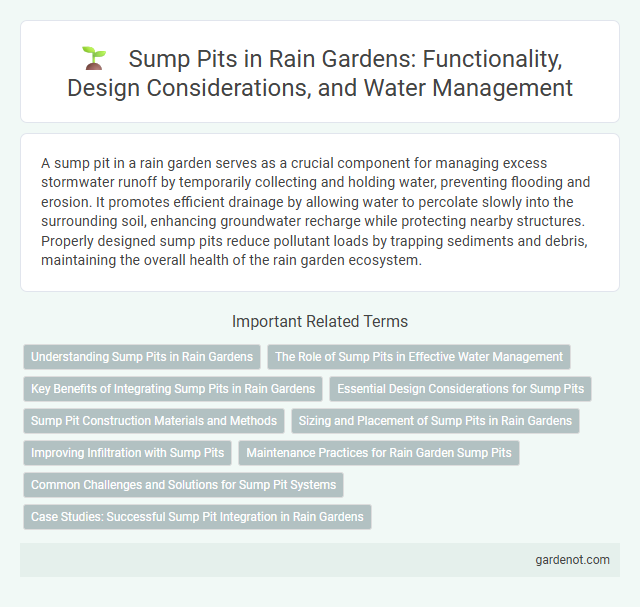A sump pit in a rain garden serves as a crucial component for managing excess stormwater runoff by temporarily collecting and holding water, preventing flooding and erosion. It promotes efficient drainage by allowing water to percolate slowly into the surrounding soil, enhancing groundwater recharge while protecting nearby structures. Properly designed sump pits reduce pollutant loads by trapping sediments and debris, maintaining the overall health of the rain garden ecosystem.
Understanding Sump Pits in Rain Gardens
Sump pits in rain gardens function as important collection points where excess stormwater accumulates before slowly infiltrating into the soil, helping to prevent surface flooding. These pits are typically designed with gravel or perforated pipes to enhance water drainage while trapping sediments and debris. Properly maintained sump pits improve rain garden efficiency by promoting groundwater recharge and reducing runoff pollution.
The Role of Sump Pits in Effective Water Management
Sump pits play a crucial role in effective water management by collecting and temporarily holding excess stormwater runoff, preventing flooding and soil erosion in rain gardens. These pits facilitate controlled infiltration, allowing water to percolate slowly into the ground and recharge groundwater supplies. Properly designed sump pits enhance the overall efficiency of rain gardens in managing urban stormwater and improving landscape sustainability.
Key Benefits of Integrating Sump Pits in Rain Gardens
Integrating sump pits in rain gardens enhances water management by efficiently collecting and temporarily storing runoff, reducing surface flooding and erosion risks. These pits improve groundwater recharge and promote healthier soil ecosystems by facilitating gradual water infiltration. By controlling stormwater flow, sump pits also protect surrounding infrastructure from water damage while supporting sustainable urban drainage systems.
Essential Design Considerations for Sump Pits
Sump pits in rain gardens require precise sizing to handle peak stormwater volumes and prevent overflow, with typical dimensions ranging from 12 to 24 inches in diameter and depths of 18 to 36 inches. Proper placement at the lowest point of the garden ensures efficient water collection and supports soil infiltration while minimizing erosion risks. Incorporating a perforated pipe connection enhances water conveyance, and selecting durable materials like concrete or polyethylene prevents structural failure under fluctuating moisture conditions.
Sump Pit Construction Materials and Methods
Sump pit construction materials often include durable concrete, polyethylene, or fiberglass to ensure water-tightness and structural integrity. Methods involve precise excavation, installation of a perforated pipe or basin to collect runoff, and proper backfilling with gravel for effective drainage. Incorporating filters or geotextile fabrics around the sump pit prevents sediment clogging, enhancing long-term functionality in rain garden systems.
Sizing and Placement of Sump Pits in Rain Gardens
Proper sizing of sump pits in rain gardens is critical to efficiently manage stormwater by temporarily holding runoff before infiltration. The sump pit volume should be calculated based on the watershed area, typical rainfall intensity, and soil infiltration rates to prevent overflow and erosion. Placement near inflow points ensures effective sediment capture and prolongs the rain garden's filtration capacity.
Improving Infiltration with Sump Pits
Sump pits enhance rain garden performance by capturing runoff and facilitating deeper water infiltration into the soil, reducing surface ponding and erosion. By directing water into these excavated pits filled with permeable materials, sump pits increase the absorption capacity of the surrounding soil, promoting groundwater recharge. Properly designed sump pits optimize stormwater management by slowing runoff flow rates and improving overall infiltration efficiency in rain garden systems.
Maintenance Practices for Rain Garden Sump Pits
Regular inspection of rain garden sump pits prevents clogging by removing accumulated sediments and debris that can obstruct water flow. Ensuring proper drainage through periodic cleaning of sump pit inlets and outlets supports optimal rainwater infiltration and reduces risk of flooding. Using protective grates and maintaining nearby vegetation minimizes sediment entry and enhances the long-term efficiency of rain garden sump pits.
Common Challenges and Solutions for Sump Pit Systems
Sump pit systems frequently encounter challenges such as clogging from sediment buildup and poor drainage due to inadequate sizing or improper installation. Solutions involve regular maintenance including sediment removal, installing a filtration system to prevent debris entry, and ensuring proper pit depth and sump pump capacity to handle stormwater volumes effectively. Using corrosion-resistant materials and designing pits with easy access points enhances system longevity and reliability in rain garden water management.
Case Studies: Successful Sump Pit Integration in Rain Gardens
Case studies highlight successful sump pit integration in rain gardens significantly improving stormwater management by efficiently collecting and temporarily storing runoff. Projects in urban areas such as Seattle and Portland demonstrate sump pits enhancing infiltration rates and reducing overflow during heavy rainfall. These implementations show measurable reductions in surface water pollution and urban flooding, proving sump pits as vital components in sustainable rain garden design.
Sump pit Infographic

 gardenot.com
gardenot.com